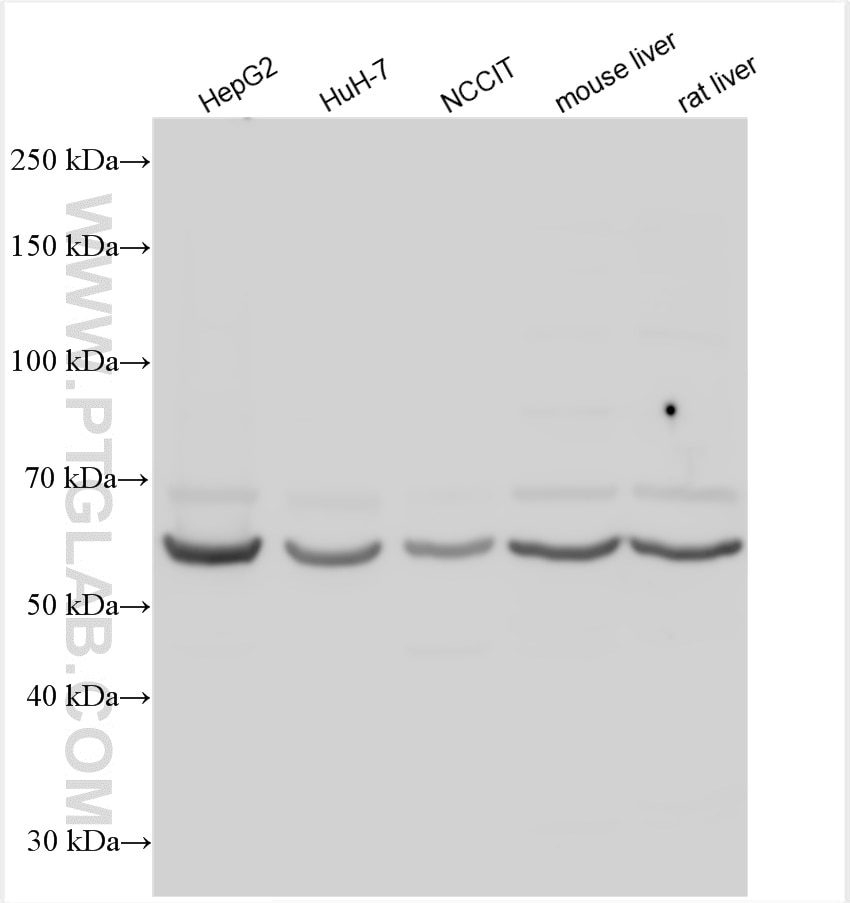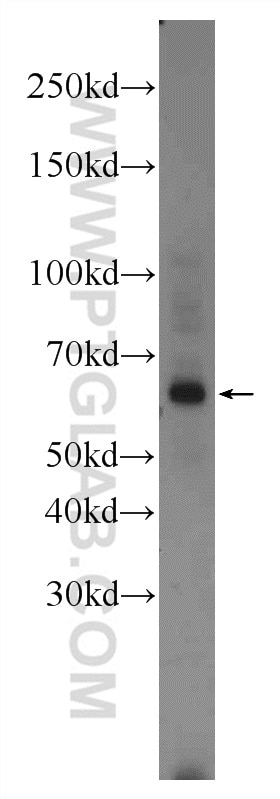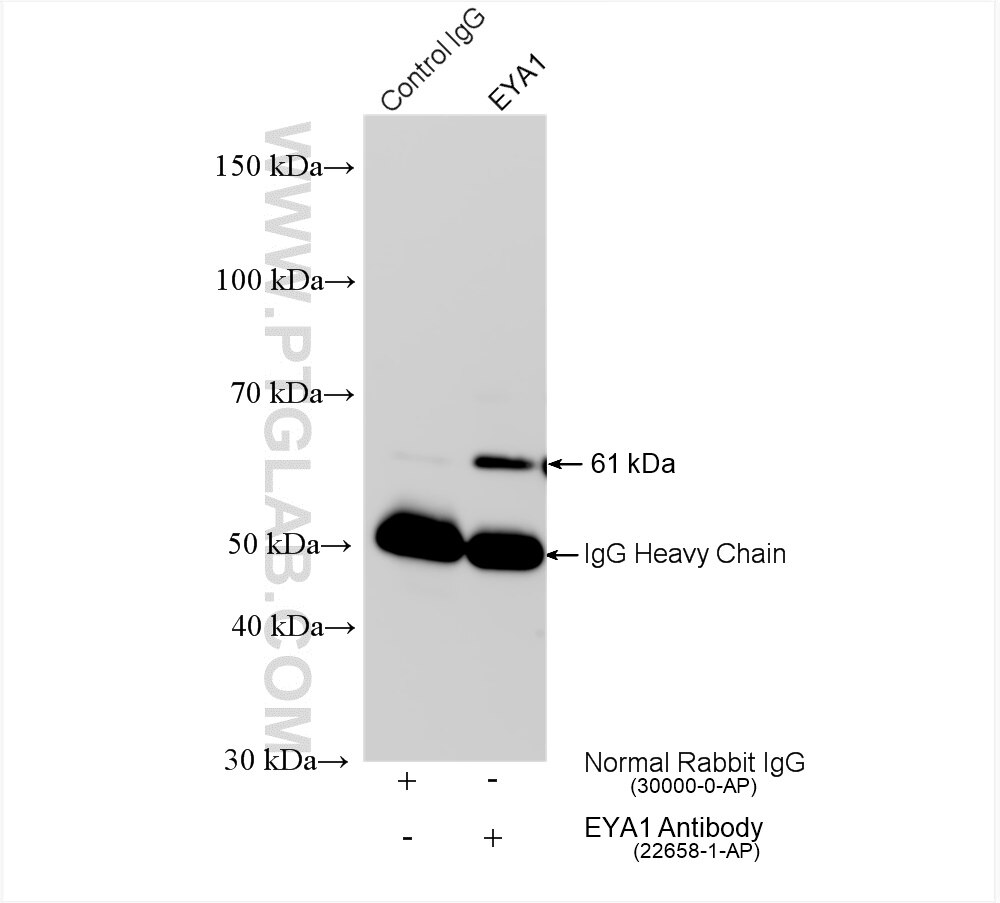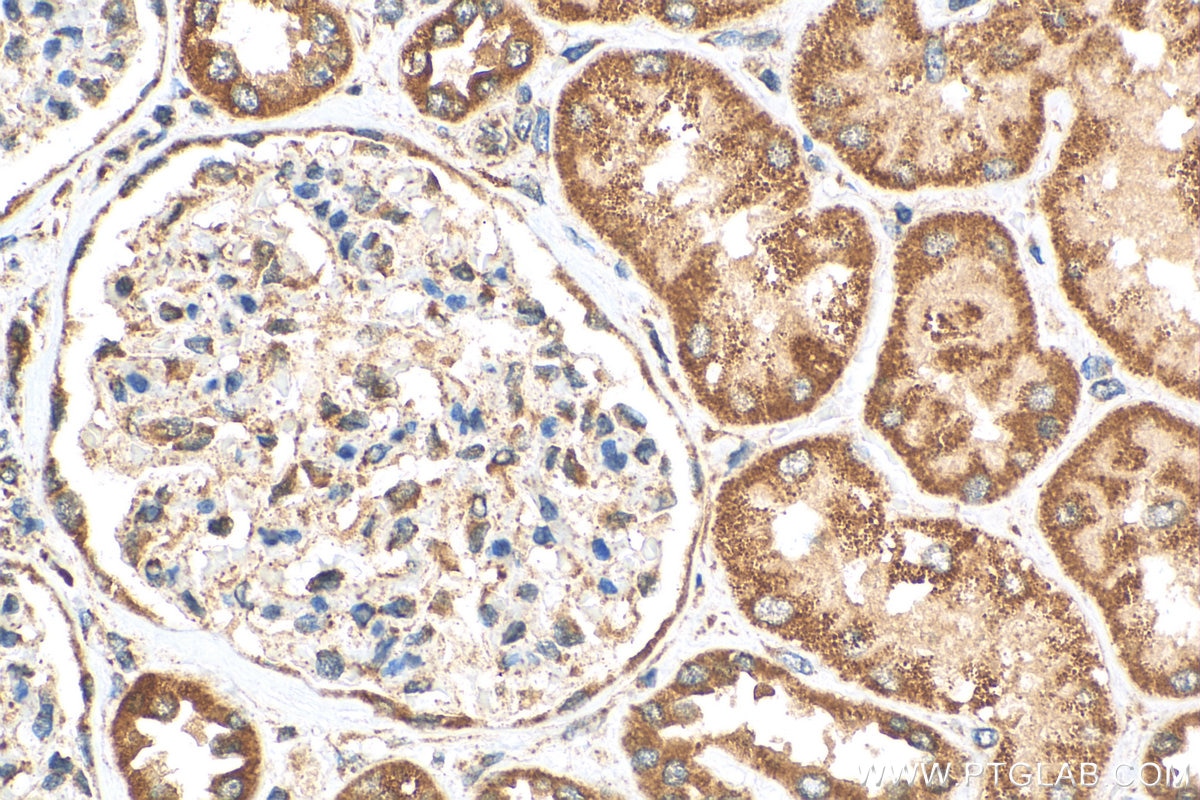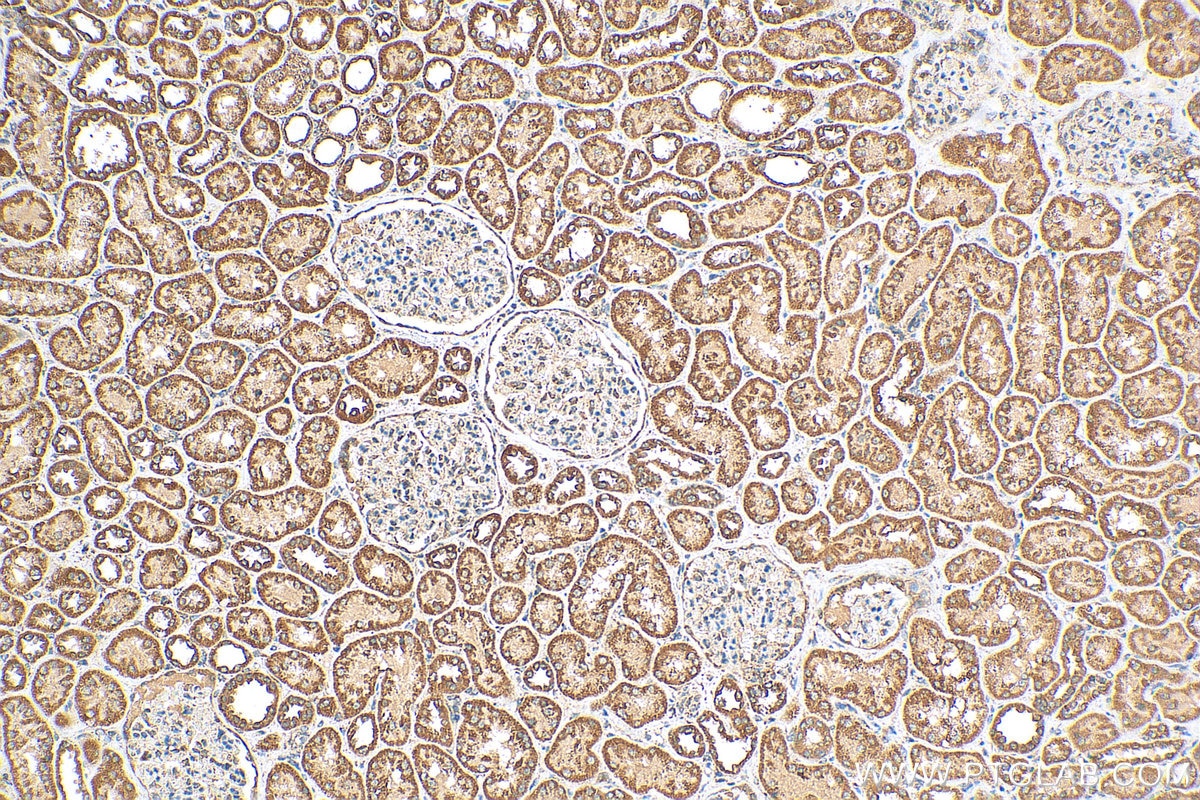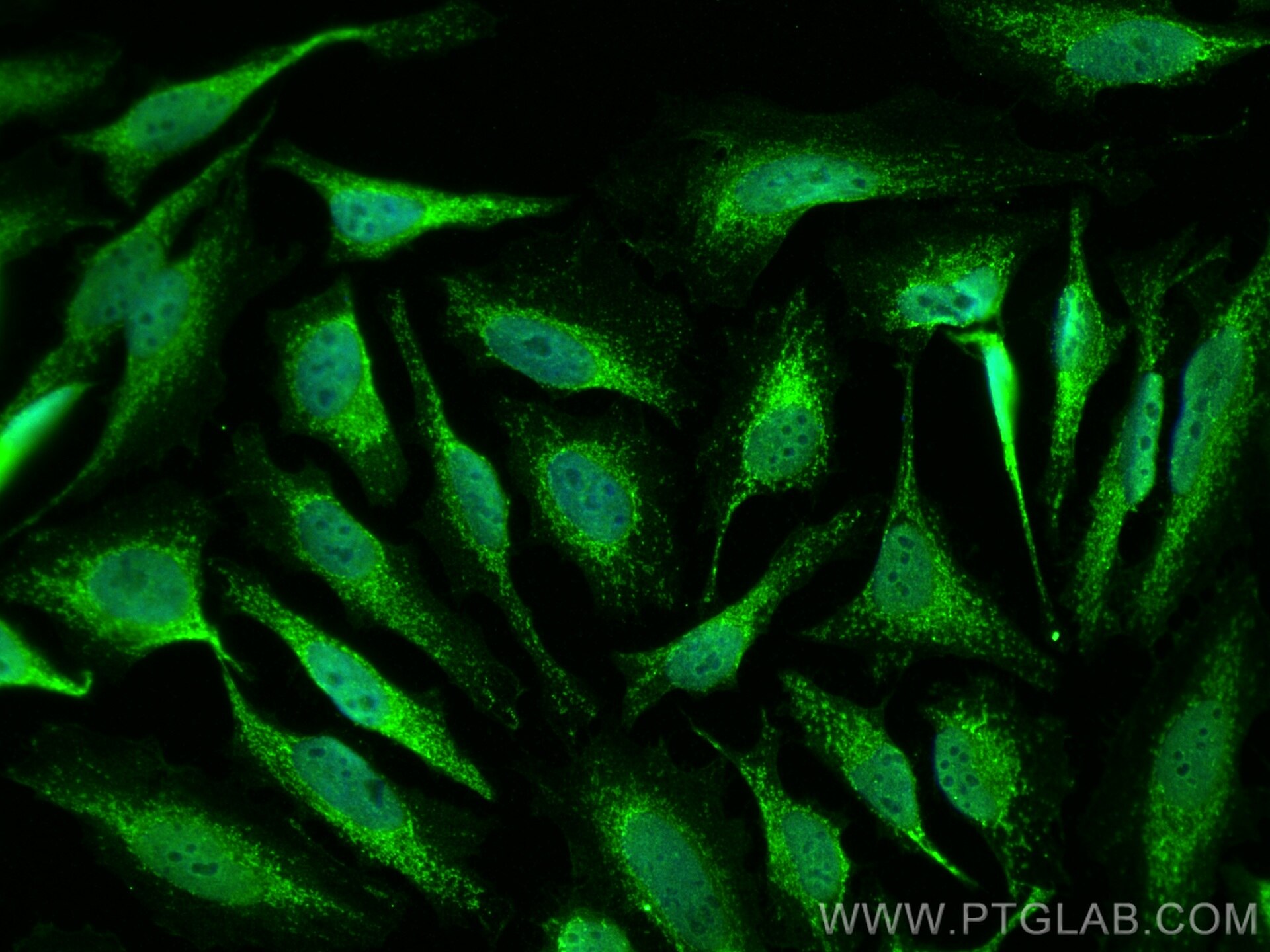- Phare
- Validé par KD/KO
Anticorps Polyclonal de lapin anti-EYA1
EYA1 Polyclonal Antibody for WB, IP, IF, IHC, ELISA
Hôte / Isotype
Lapin / IgG
Réactivité testée
Humain, rat, souris
Applications
WB, IHC, IF/ICC, IP, CoIP, ELISA
Conjugaison
Non conjugué
N° de cat : 22658-1-AP
Synonymes
Galerie de données de validation
Applications testées
| Résultats positifs en WB | cellules HepG2, cellules HuH-7, cellules NCCIT, tissu de côlon de souris, tissu hépatique de rat, tissu hépatique de souris |
| Résultats positifs en IP | cellules HepG2, |
| Résultats positifs en IHC | tissu rénal humain, il est suggéré de démasquer l'antigène avec un tampon de TE buffer pH 9.0; (*) À défaut, 'le démasquage de l'antigène peut être 'effectué avec un tampon citrate pH 6,0. |
| Résultats positifs en IF/ICC | cellules HeLa, |
Dilution recommandée
| Application | Dilution |
|---|---|
| Western Blot (WB) | WB : 1:2000-1:10000 |
| Immunoprécipitation (IP) | IP : 0.5-4.0 ug for 1.0-3.0 mg of total protein lysate |
| Immunohistochimie (IHC) | IHC : 1:250-1:1000 |
| Immunofluorescence (IF)/ICC | IF/ICC : 1:200-1:800 |
| It is recommended that this reagent should be titrated in each testing system to obtain optimal results. | |
| Sample-dependent, check data in validation data gallery | |
Applications publiées
| KD/KO | See 2 publications below |
| WB | See 8 publications below |
| IHC | See 4 publications below |
| IF | See 4 publications below |
| IP | See 1 publications below |
| CoIP | See 1 publications below |
Informations sur le produit
22658-1-AP cible EYA1 dans les applications de WB, IHC, IF/ICC, IP, CoIP, ELISA et montre une réactivité avec des échantillons Humain, rat, souris
| Réactivité | Humain, rat, souris |
| Réactivité citée | rat, Humain |
| Hôte / Isotype | Lapin / IgG |
| Clonalité | Polyclonal |
| Type | Anticorps |
| Immunogène | EYA1 Protéine recombinante Ag18489 |
| Nom complet | eyes absent homolog 1 (Drosophila) |
| Masse moléculaire calculée | 592 aa, 65 kDa |
| Poids moléculaire observé | 61 kDa and 65 kDa |
| Numéro d’acquisition GenBank | BC121799 |
| Symbole du gène | EYA1 |
| Identification du gène (NCBI) | 2138 |
| Conjugaison | Non conjugué |
| Forme | Liquide |
| Méthode de purification | Purification par affinité contre l'antigène |
| Tampon de stockage | PBS avec azoture de sodium à 0,02 % et glycérol à 50 % pH 7,3 |
| Conditions de stockage | Stocker à -20°C. Stable pendant un an après l'expédition. L'aliquotage n'est pas nécessaire pour le stockage à -20oC Les 20ul contiennent 0,1% de BSA. |
Informations générales
The EYA1 (Eyes absent homolog 1) gene is the human homologue of the Drosophila Eya1 gene, which is essential for eye development in that species. There are 4 different isoforms of EYA1 (EYA1A, EYA1B, EYA1C, EYA1D), which are composed of 559 amino acids (AA), 592 AA, 592 AA and 557 AA, respectively. It should be noted that isoforms B and C have the same length; however, they could be considered different variants because of change in amino acidic composition (PMID: 24803398).
Protocole
| Product Specific Protocols | |
|---|---|
| WB protocol for EYA1 antibody 22658-1-AP | Download protocol |
| IHC protocol for EYA1 antibody 22658-1-AP | Download protocol |
| IF protocol for EYA1 antibody 22658-1-AP | Download protocol |
| IP protocol for EYA1 antibody 22658-1-AP | Download protocol |
| Standard Protocols | |
|---|---|
| Click here to view our Standard Protocols |
Publications
| Species | Application | Title |
|---|---|---|
Cell Rep YTHDF1 phase separation triggers the fate transition of spermatogonial stem cells by activating the IκB-NF-κB-CCND1 axis | ||
Front Oncol SIX1 Activates STAT3 Signaling to Promote the Proliferation of Thyroid Carcinoma via EYA1. | ||
Oncotarget Eyes absent gene (EYA1) is a pathogenic driver and a therapeutic target for melanoma.
| ||
Stem Cell Res Ther Co-transplantation with adipose-derived cells to improve parathyroid transplantation in a mice model. | ||
Clin Breast Cancer Dachshund 1 is Differentially Expressed Between Male and Female Breast Cancer: A Matched Case-Control Study of Clinical Characteristics and Prognosis. | ||
J Mol Neurosci MES23.5 DA Immortalized Neuroblastoma Cells Self-protect Against Early Injury by Overexpressing Glial Cell-derived Neurotrophic Factor via Akt1/Eya1/Six2 Signaling. |
